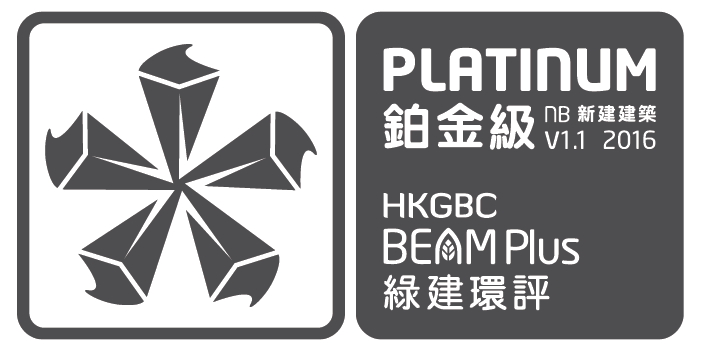


| Completion Year | 2014 |
| Number of Blocks | 1 |
| Number of Floors | 10 |
| Type | Government, Institutional and Community |
| Project Developer / Owner | Hang Seng Management College |
| Project Manager | Hang Seng Management College |
| Architect | Wong & Ouyang (HK) Llimited |
| Landscape Architect | Urbis Limited |
| M&E Engineer | Wong & Ouyang (Building Services) Llimited |
| C&S Engineer | URS Hong Kong Limited |
| Main Contractor | Kaden Construction Limited |
| Quantity Surveyor | Rider Levett Bucknall Limited |
| Environmental Consultant | Allied Environmental Consultants Limited |
| Facility Manager | Hang Seng Management College |
Hang Seng Management College is environmentally responsive and the building design infuses innovative environmental ideas, such as using district cooling system to promote sustainability. Passive design is embraced; high efficient building services and environmentally friendly materials are widely implemented. With the adoption of the chilled ceiling systems at classrooms, corridors and offices, the use of electrical power can be reduced as much as 25 to 30%.
Hang Seng Management College is located at the suburban area in Shatin. As an environmentally responsive institution, the College organises regular activities to propagate the sustainability concept. On site design level, all relevant sub-items of the Urban Design Guidelines have been addressed. In particular, stepped height design approach is adopted for the entire site to reduce the building massing and reserve a visual corridor viewing the ridgeline of Tate's Cairn and existing green feature. Extensive use of greenery was given after thorough assessments to improve the ecological value. Open space, outdoor sitting areas and bicycle racks are provided to encourage site usage by locals and public. Environmentally friendly resources are widely implemented in the building design. High emissivity roofing and ecofriendly materials, high efficiency building services and water using devices were employed with detailed analysis to optimise the material use, building-energy performance and water conservation during design stage. Building materials were selected with the intended use of regionally manufactured materials, rapidly renewable materials (Bamboo) and reusable materials. Rainwater will be reclaimed and every kind of waste (including construction) shall be reduced and recycled before disposed of. Curtain walls were built strategically to maximise incoming daylight. With respect to the sustainability concern, durable and loose fit materials such as curtain wall, glass, terracotta and fins were installed. Wind corridor is kept in the site scale to allow penetration of natural wind. Tremendous effort has been in place to infuse innovative and sustainability ideas, such as radiant chilled ceiling and district cooling system promote sustainability. Building management system is installed to optimise the operational energy use. Financial budget is reserved to monitor and review on operation and maintenance with respect to the consultation results from staff and students on the building performance.
Hang Seng Management College is environmentally responsive and the building design infuses innovative environmental ideas, such as using district cooling system to promote sustainability. Passive design is embraced; high efficient building services and environmentally friendly materials are widely implemented.








Adequately day-lit


Chilled ceiling system
People
A sustainable building starts with due consideration on people and thus HSMC campus embraces the following principles:
Campus for the 21st Century
As Hang Seng Management College is developing into one of the leading tertiary education institutions in Hong Kong with increasing investments in estate and learning technologies, it is necessary to provide a campus design with cost-effective space utilization that meets the growing needs of the College.
Learning Campus
Within recent years, campuses have seen dramatic shifts in technology, teaching paradigms, study habits, cross disciplinary programmes, diversity, and the evolution of the living / learning campus where the line between a student’s socialisation and education cannot be distinguished. Students increasingly learn wherever there are opportunities for interaction. The entire campus is a learning place. There is a proven connection between academic performance, retention, graduation rates, and the qualities of the campus environment beyond the classroom. The learning campus maximises the probability of chance encounters and encourages lingering, whether alone or in groups. The learning campus is dynamic. Boundaries between formal and informal activities fade. The physical campus therefore plays a key role in expressing and achieving the Hang Seng Management College’s mission and objectives as the leading private university in Hong Kong providing top quality business education. The Campus itself has been conceived as a place that teaches, with a host of sustainable measures installed. Through daily use of the buildings, the students participate and understand sustainable issues. With the open campus policy, sustainable concepts reach a wider local community who use the buildings.
Connectivity – The College Street
With the expansion of the campus facilities and substantial increase in student and staff numbers, circulation and connectivity vertically and horizontally throughout the campus is of fundamental importance. We intend to develop the concept of Connectivity in the form of a "College Street" as the main theme for the Hang Seng Management College Campus. The Street will organise a variety of educational and social activities harbouring opportunities for encounter and give clear access to teaching and amenity, civic and academic spaces.
Policy
The Government and stakeholders’ corporate policies have tremendous influences on sustainable development. There has been rising public concern over the quality and sustainability of the built environment. To enhance the quality and sustainability of the built environment the Buildings Department in 2011 stipulated a Sustainable Building Design Guideline, which is a pre-requisite for GFA concessions for all green / amenity features and non-mandatory plant rooms and services, to promote sustainable building designs and energy efficient features in new developments. Moreover, participation in the BEAM Plus certification scheme by the Hong Kong Green Building Council is also a requirement for GFA concessions. Due to existing site constraints and tight programme, GFA concessions have not been applied for the project. However, despite that GFA concessions were not applied, it was the decision of the College for all buildings in the campus to take part in BEAM Plus certification, with the target of Platinum rating, in order to support local sustainable design development.
Process
The project is a showcase of how sustainable concepts evolve in construction project in Hong Kong. At the outset of the project, there was no specific target or requirement in relation to sustainable design and therefore no particular budget allocated to sustainable design was allowed. In response to a greater social awareness and demand, and the rising standards of construction industry, HSMC considered that it was their social responsibility to promote sustainable design in campus and also demonstrate their ability of the College to communicate its leadership role in teaching environmentally social behaviour and its status as a world-class institution. Owing to this, HSMC, with the advice of the Consultant Team, committed to putting into additional funding for the project to target platinum rating of BEAM Plus certification, demonstrating their great commitment to supporting local sustainability development.
Performance
The development is a showcase of excellence in “sustainable built environment” performance with measurement and verifications. HSMC did not cease looking for opportunities to adopt new design philosophy and technologies in sustainable development.
Building D is one of the first institutional buildings in HK to adopt chilled ceiling design which significantly reduces annual energy consumption cost of HVAC by 20% in the first year operation. It also promotes a new concept and behaviour of using HVAC which steer HVAC energy reduction in a long run. The project is also an exemplar of extensive use of bamboo to replace wood in building construction. Bamboo, having a tremendously faster growth rate than trees, is a long-term solution to preserve trees and the project is just the ideal of showing how this can be realised. The bamboo has been widely adopted in most areas such as the College Chamber, entrance lobbies and external landscape areas as finishes materials.
| Completion Year | 2014 |
| Number of Blocks | 1 |
| Number of Floors | 10 |
| Type | Government, Institutional and Community |
| Project Developer / Owner | Hang Seng Management College |
| Project Manager | Hang Seng Management College |
| Architect | Wong & Ouyang (HK) Llimited |
| Landscape Architect | Urbis Limited |
| M&E Engineer | Wong & Ouyang (Building Services) Llimited |
| C&S Engineer | URS Hong Kong Limited |
| Main Contractor | Kaden Construction Limited |
| Quantity Surveyor | Rider Levett Bucknall Limited |
| Environmental Consultant | Allied Environmental Consultants Limited |
| Facility Manager | Hang Seng Management College |